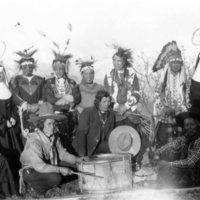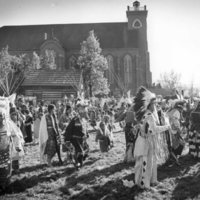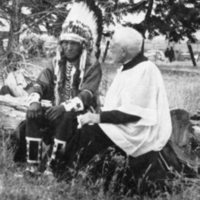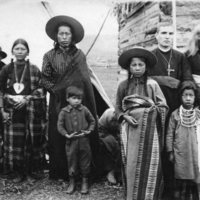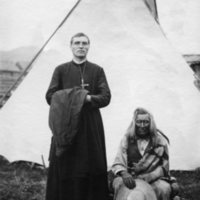Catholicism as a Meeting Space
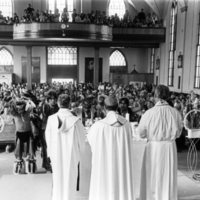
Several Natives have dressed up in their Native garb and are preforming at the front of a Catholic mass. We can see white and Native people in communion here, both being tolerant of each other.
In reading his diary, Father Griva gives us insight into his day-to-day activities. He takes us from place to place as he journeys from Spokane, to Nespelem, even to Seattle at one point. Many of his entries are rather pedestrian, speaking about him taking care of business or giving mass as usual. While his diary entries might be pedestrian, Father Griva is not typical for his time. One thing that made Father Griva unique for his time was his enthusiasm for learning what he calls, "Indian". Father Griva was among the first of white people to be able to read and speak in "Indian". Moreover, in his autobiography, Father Griva also recognizes that, "many people have the idea that one Indian language helps to learn another. It is not so by any means." While this concept seems obvious to a modern linguist, this was a rare thought for a white person to have at the time.
Father Griva's forward thinking is also evident in his preaching habits, noting constantly when he was preaching to, baptising, or hearing confessions from Native people. In some instances, Father Griva was preaching exclusively in Native tongue, something that was increasingly rare at the time (Edward Griva, "Missions of the Sacred Heart at Nespelem," Vol. 48, 1919 pg 72).
From Griva's diary, it's clear that he is primarily there as a Jesuit missionary. His job is the convert Native people to Christianity, and he does so effectively. There are countless instances of Griva baptizing, giving first communion to, preaching to, or hearing confessions from both Native and white people in his communities. As one reads through his diary, Griva makes it increasingly clear that he is in the communities for the benefit of the communities. Whether he's working on a well or performing his pastoral duties, sometimes up to 3 masses per day, Father Griva makes his communities, Native or white, his first priority, moreso than his own heal and wellness.
While there will always be a division between people who have a language barrier, Griva gives the people a common ground, something that white and Native alike can bond over: religion. From a young age, the children are brought together through Christianity, as is evidenced by Griva recalling his work on January 11, 1920 being, "in Indian & English - taught Sunday school & gave benediction" (Edward Griva, "Missions of the Sacred Heart at Nespelem," Vol. 48, 1919 pg 71). In these moments of community between the Natives and white people are the signs of reaparing the relationships that were shattered in the warring periods of the 19th century. These moments are mainly centered around Christianity, using their common religion to find a meeting space.

